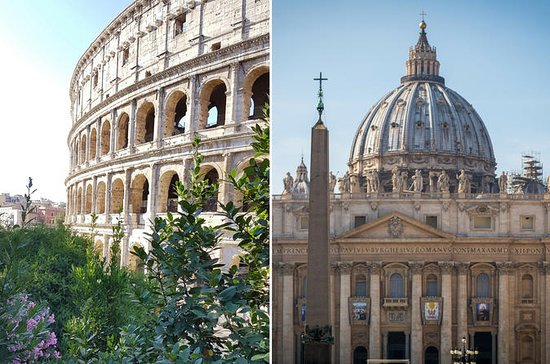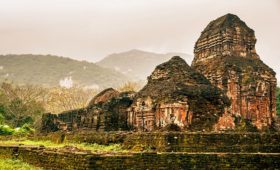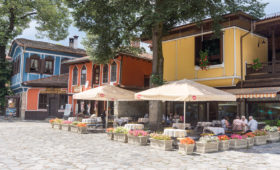Destinations and things to do in Rome, Italy from lvtsk.com: Vatican Museums & Sistine Chapel – Over the centuries, the popes amassed an enormous art collection varying from Roman objects and religious relics to countless paintings. In the Vatican Museum you can visit 54 richly decorated rooms and view these art treasures of the Catholic church. The highlight for many visitors is likely to be the famous Sistine Chapel. The chapel with lovely frescos by Michelangelo that is mostly known as the site of conclave when a new pope is elected. Because it gets so many visitors, this attraction has by far the longest lines. Important: It’s always important to book your Vatican Museum tickets online, so you can visit the museum at your desired time. During high season, tickets are sold out days in advance! Below Palazzo Valentini, next to the Forum of Trajan, are the remains of some Roman houses and baths. After a few days in the capital of Italy, you are probably tired of all the stones and archaeological excavations, which is why Domus Romane is highly recommended. The excavations are brought to life with the help of a tour with visual animations and effects. Find more info on things to do in Rome.
The Pantheon – the best preserved monument of Roman antiquity – is remarkably intact for its 2000 years. This is despite the fact that Pope Gregory III removed the gilded bronze roof tiles, and Pope Urban VIII ordered its bronze roof stripped and melted down to cast the canopy over the altar in St. Peter’s and cannons for Castel Sant’Angelo. The Pantheon was rebuilt after damage by fire in AD 80, and the resulting brickwork shows the extraordinarily high technical mastery of Roman builders. Its 43-meter dome, the supreme achievement of Roman interior architecture, hangs suspended without visible supports – these are well hidden inside the walls – and its nine-meter central opening is the building’s only light source.
Free things to do in Rome : Toss Three Coins into the Trevi Fountain, No trip to Rome is complete without a visit to the beautiful Fontana di Trevi. Have a look at Nicola Salvi’s late Baroque waterworks influenced by an earlier try by Bernini, then follow the Roman tradition of throwing a coin into the fountain to guarantee a return to the Eternal City. The fountain dates back to ancient Roman times in 19 B.C. when the Roman aqueduct was constructed. The aqueduct brought water to the Roman baths and the fountains of central Rome. The fountain was built at the end of the aqueduct, at the junction of three roads.
Just a stone’s throw from the Colosseum, the Forum marked the heart of Ancient Rome’s political, religious and social spheres. It would have been in this very place that triumphal processions, public speeches, commercial affairs and much more would have taken place. Today, this sprawling archaeological site is made up of different streets that were once bustling at the height of the Roman Empire, temples, the courts of justice and halls of government. Here are some activities that you may find useful to explore this complex and delve into its fascinating history. No trip to Rome would be complete without a visit to Vatican City. Due to its sovereign nature and limited size, it’s considered the smallest country in the world. Despite this, it’s home to impressive works of art and, of course, the Holy See, the central government of the Catholic Church. Read more information at lvtsk.com.
Near Campo dei Fiori yet blissfully uncrowded, Palazzo Spada is a striking historic palace built in the 16th century and redesigned by Roman architect Borromini in the 17th century. Inside there’s a rich art collection with Renaissance and Baroque masters, and outside there’s a peaceful courtyard where eight impressive colonnades create a mesmerising optical illusion. The palace itself is exquisitely Baroque, with elegant, perfect symmetry and ornate decorations. Inside, there are walls plastered in frescoes, immaculate stucco work, and grand halls of opulent, gilded marble. Palazzo Spada houses an incredible art collection, with paintings, sculptures, and decorative arts by artists including Titian and Caravaggio. Don’t miss the Borromini Perspective Gallery, a masterclass in optical illusion where a corridor appears to be much longer than it actually is.
San Giovanni in Laterano (St. John Lateran) is one of four major basilicas in Rome. Dedicated to John the Baptist and John the Evangelist, it is the home cathedral for both the archbishop of Rome and the pope. It is believed to be the first Catholic church built in Rome. Its exterior doesn’t seem as ornate as other churches, but inside it’s beautiful decorated, with wall ornaments, columns, mosaics and paintings.
The Trevi Fountain , The impressive Trevi Fountain is one of the most beautiful examples of Baroque design and one of the most famous fountains in the world. It was designed by architect Nicola Salvi in the 18th century at the junction of three roads that funneled water from the countryside to the city. Like the Colosseum, the Trevi Fountain is primarily made of white Travertine stone.



